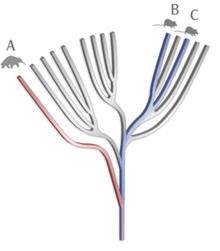EDGE species

Evolutionarily Distinct and Globally Endangered (EDGE) species are animal species which have a high EDGE score, a metric combining endangered conservation status with distinctiveness of taxon. Distinctive species have few closely related species, and EDGE species are often the only surviving member of their genus or even higher taxonomic rank. The extinction of such species would therefore represent a disproportionate loss of unique evolutionary history, biodiversity and potential for future evolution.
Some EDGE species, such as elephants and pandas, are well known and already receive considerable conservation attention, but many others, such as the Vaquita (the world’s rarest cetacean)[1] the bumblebee bat (arguably the world’s smallest mammal) and the egg-laying long-beaked echidnas are highly threatened yet remain poorly understood and are frequently overlooked by existing conservation frameworks. Recent research indicates that 70% of the world’s most threatened and evolutionarily distinct mammal species are currently receiving little or no conservation attention.[2]
The Zoological Society of London (ZSL) has launched a global conservation initiative, the EDGE of Existence Programme to raise awareness and funds for the conservation of these species.
Calculating EDGE Scores
ED

Some species are more distinct than others because they represent a larger amount of unique evolution. Species like the aardvark have few close relatives and have been evolving independently for many millions of years. Others like the domestic dog originated only recently and have many close relatives. Species uniqueness’ can be measured as an 'Evolutionary Distinctiveness' (ED) score, using a phylogeny, or evolutionary tree. ED scores are calculated relative to a clade of species descended from a common ancestor. The three clades for which the EDGE of Existence Programme has calculated scores are all classes, namely mammals, amphibians, and corals.
The phylogenetic tree has the most recent common ancestor at the root, all the current species as the leaves, and intermediate nodes at each point of branching divergence. The branches are divided into segments (between one node and another node, a leaf, or the root). Each segment is assigned an ED score defined as the timespan it covers (in millions of years) divided by the number of species at the end of the subtree it forms. The ED of a species is the sum of the ED of the segments connecting it to the root. Thus, a long branch which produces few species will have a high ED, as the corresponding species are relatively distinctive, with few close relatives. ED metrics are not exact, because of uncertainties in both the ordering of nodes and the length of segments.
GE
GE is a number corresponding to a species' conservation status according to the International Union for Conservation of Nature (IUCN) with more endangered species having a higher GE:
| Conservation status | Code | GE score |
|---|---|---|
| Extinct | EX | — |
| Extinct in the wild | EW | — |
| Critically endangered | CR | 4 |
| Endangered | EN | 3 |
| Vulnerable | VU | 2 |
| Near threatened | NT | 1 |
| Least concern | LC | 0 |
| Data deficient | DD | — |
| Not evaluated | NE | — |
EDGE
The EDGE score of a species is derived from its scores for Evolutionary Distinctness (ED) and for Globally Endangered status (GE) as follows:
This means that a doubling in ED affects the EDGE score almost as much as increasing the threat level by one (e.g. from Vulnerable to Endangered). EDGE scores are an estimate of the expected loss of evolutionary history per unit time.
EDGE species are species which have an above average ED score and are threatened with extinction (Critically Endangered, Endangered or Vulnerable). There are currently 564 EDGE mammal species (≈12% of the total). Potential EDGE species are those with high ED scores but whose conservation status is unclear (Data deficient or Not evaluated).
Focal species
Many EDGE species are not being adequately protected by existing conservation measures. This suggests that a disproportionate amount of evolutionary history is likely to be lost in the near future. To redress this balance, ten focal species are selected each year for which active research and conservation programmes will be carried out.
The focal species are the subject of research programmes aimed at establishing what the main threats are and what actions need to be taken to ensure their survival. Each study is focused on delivering a conservation action plan. These plans provide information on the conservation actions highlighted by the research programme, and identify key stakeholders that will carry out these actions.
2007/8 focal mammal species
Numbers refer to EDGE rank
- 1. Yangtze River dolphin (Lipotes vexillifer)
- 2. Attenborough’s long-beaked echidna (Zaglossus attenboroughi)
- 5. Hispaniolan solenodon (Solenodon paradoxus)
- 8. Wild Bactrian camel (Camelus ferus)
- 21. Pygmy hippopotamus (Hexaprotodon liberiensis)
- 22. Slender loris (Loris tardigradus)
- 37. Hirola antelope (Beatragus hunteri)
- 46. Golden-rumped elephant-shrew (Rhynchocyon chrysopygus)
- 49. Bumblebee bat (Craseonycteris thonglongyai)
- 81. Long-eared jerboa (Euchoreutes naso)
2008/9 focal amphibian species
- 2. Chinese giant salamander (Andrias davidianus)
- 3. Sagalla caecilian (Boulengerula niedeni)
- 4. Purple frog (Nasikabatrachus sahyadrensis)
- 15. Ghost frogs (Heleophryne hewitti and Heleophryne rosei)
- 18. Olm (Proteus anguinus)
- 24. Lungless Mexican salamanders (20 species from the top ranked 100 species, including Parvimolge townsendi, Chiropterotriton lavae, Chiropterotriton magnipes and Chiropterotriton mosaueri)
- 37. Malagasy rainbow frog (Scaphiophryne gottlebei)
- 45. Chile Darwin's frog (Rhinoderma rufum)
- 55. Betic midwife toad (Alytes dickhilleni)
- 69. Seychelles frogs (Sooglossus gardineri, Sooglossus pipilodryas, Sooglossus sechellensis and Sooglossus thomasseti)
See also
References
- ↑ Gulf of California Harbor Porpoise/ Vaquita/ Cochito/ (Phocoena sinus). (2012). National Oceanographic and Atmospheric Administration Office of Protected Resources.
- ↑ Isaac, N. J. B.; Turvey, S. T.; Collen, B.; Waterman, C. (2007). "Mammals on the EDGE: conservation priorities based on threat and phylogeny". PLoS ONE. 2 (3): e296. doi:10.1371/journal.pone.0000296. PMC 1808424. PMID 17375184.
External links